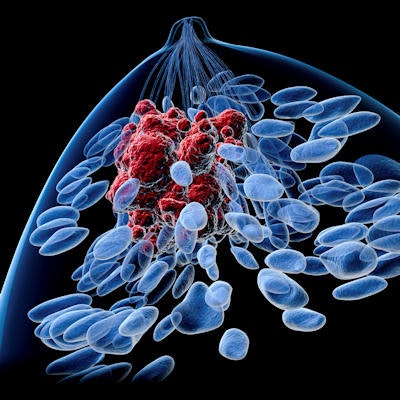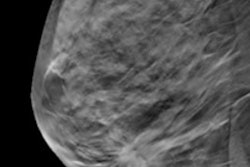
Adding digital breast tomosynthesis (DBT) to digital mammography boosts diagnostic accuracy for finding additional ipsilateral and contralateral breast cancer in women with nondense breast tissue, according to a study published online April 9 in Radiology.
The findings address a knowledge gap for how DBT performs in breast cancer staging in this population, wrote a team led by Dr. Marion Fontaine of Montpellier University Hospital in France.
"Combined digital mammography and DBT has increased cancer detection rates when compared with those achieved with digital mammography-only screening," the group wrote. "However, there is limited literature on DBT as an adjunct to mammography in the staging of known breast cancers."
To address this gap, the researchers compared the diagnostic accuracy of digital mammography to that of digital mammography and DBT for identifying additional ipsilateral and contralateral breast cancer lesions in women newly diagnosed with the disease.
The study included 166 women with breast cancer who underwent digital mammography alone and a combination digital mammography/DBT exam. Four radiologists read the exams and rated them using the BI-RADS system; breast MRI and pathologic results were used as reference standard for all lesions. Fontaine's group tracked sensitivity, specificity, and area under the receiver operating curve (AUC) for both types of exams.
The team found that 83 women (50%) had additional ipsilateral lesions (both multifocal and multicentric) and 18 (11%) had bilateral lesions. The combination of digital mammography plus DBT was more sensitive for multicentric and ipsilateral lesions and had a higher AUC for bilateral lesions than digital mammography alone. The researchers found no statistically significant differences in specificity.
| Performance in identifying additional ipsilateral and contralateral breast cancer lesions in women with nondense breast tissue | |||
| Performance measure | Digital mammography alone | Digital mammography plus DBT | p-value |
| Sensitivity | |||
| Multicentric lesions | 37% | 51% | < 0.01 |
| Ipsilateral lesions | 44% | 52% | < 0.01 |
| Bilateral lesions | 47% | 56% | 0.19 |
| Specificity | |||
| Multicentric lesions | 94% | 94% | 0.87 |
| Ipsilateral lesions | 90% | 91% | 0.51 |
| Bilateral lesions | 89% | 88% | 0.70 |
| AUC | |||
| Multicentric lesions | 0.68 | 0.71 | 0.16 |
| Ipsilateral lesions | 0.69 | 0.71 | 0.10 |
| Bilateral lesions | 0.67 | 0.74 | 0.02 |
It may be surprising that the study found benefit in the combination of digital mammography and DBT in women with nondense tissue, wrote Dr. Linda Moy of New York University in New York City in an accompanying editorial.
"[The study results] may seem counterintuitive, given that tomosynthesis is known to improve visualization of breast cancer by reducing the effects of tissue superimposition, particularly in women with dense breasts," Moy wrote. "Nonetheless, DBT is still an x-ray projection technique, and it may not depict a mass if its margins are obscured by adjacent dense breast tissue. A fat-breast interface is necessary to enable detection of masses and architectural distortion."
More research is needed, according to Moy.
"Further study is warranted to assess the long-term outcomes of additional cancers detected with DBT," she concluded. "Although questions regarding tumor biology remain, this study contributes to our understanding of breast cancers detected with tomosynthesis."




















